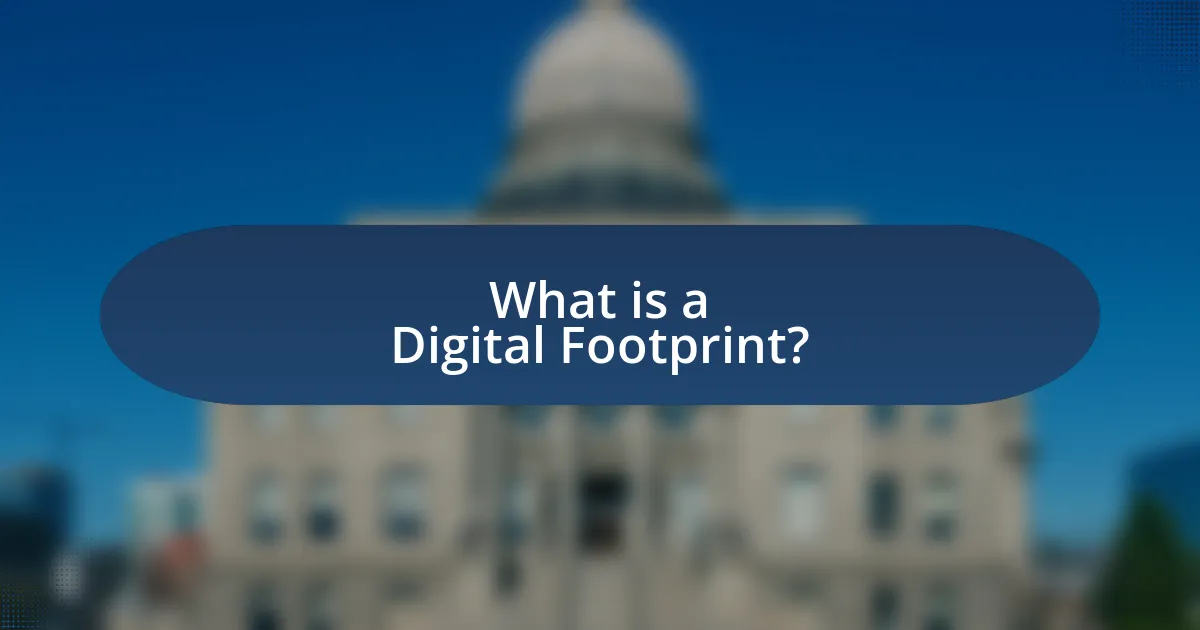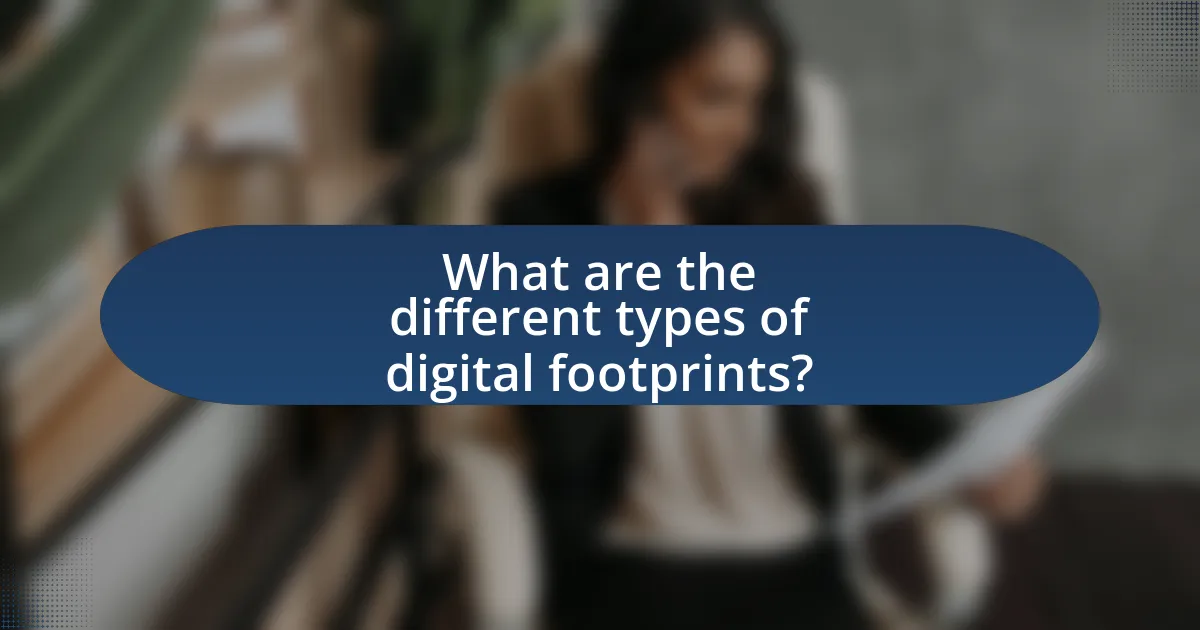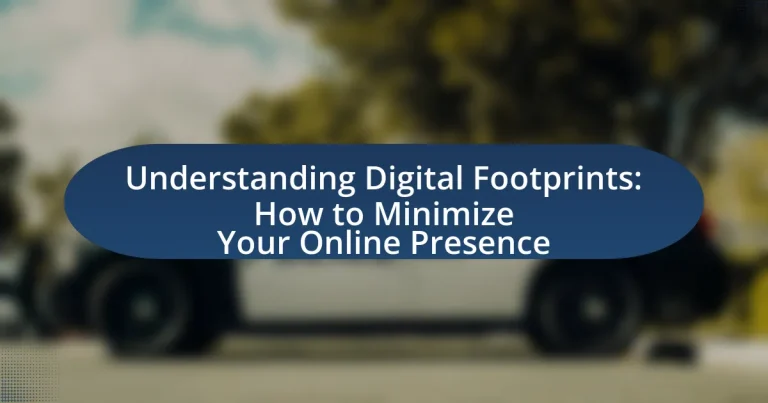A digital footprint refers to the trail of data individuals leave while using the internet, encompassing both active footprints, created through intentional sharing, and passive footprints, generated without direct input. This article explores how digital footprints are formed through various online activities, the types of information they include, and the implications for personal privacy and reputation. It highlights the risks associated with a large digital footprint, such as identity theft and reputational damage, and provides strategies for minimizing online presence, including managing privacy settings and utilizing privacy-focused tools. Understanding and managing one’s digital footprint is crucial for protecting personal information and enhancing online security.

What is a Digital Footprint?
A digital footprint is the trail of data that individuals leave behind while using the internet, which includes information such as browsing history, social media activity, and online purchases. This data can be categorized into two types: active digital footprints, which are created intentionally by users when they share information, and passive digital footprints, which are collected without the user’s direct input, such as through cookies and tracking technologies. Research indicates that 90% of online data is generated by users, highlighting the significant impact of digital footprints on personal privacy and online identity.
How is a digital footprint created?
A digital footprint is created through the online activities and interactions of an individual, including browsing websites, posting on social media, and using online services. Each action generates data that is collected and stored by various platforms, such as search engines and social media sites. For instance, when a user searches for information on Google, the search terms and the websites visited are logged, contributing to the user’s digital footprint. Additionally, social media interactions, such as likes, shares, and comments, further enhance this footprint by providing insights into personal preferences and behaviors. According to a study by the Pew Research Center, 90% of adults in the U.S. have taken steps to manage their digital footprints, highlighting the significance of understanding how these footprints are formed.
What types of information contribute to a digital footprint?
A digital footprint is primarily composed of information generated through online activities. This includes data such as social media interactions, website visits, online purchases, email communications, and search history. Each of these activities leaves a trace that can be tracked and analyzed, contributing to an individual’s overall digital presence. For instance, a study by the Pew Research Center indicates that 90% of Americans are concerned about their online privacy, highlighting the significance of understanding what constitutes a digital footprint.
How do online activities influence your digital footprint?
Online activities significantly influence your digital footprint by generating data that reflects your online behavior, preferences, and interactions. Each action, such as browsing websites, posting on social media, or making online purchases, creates a traceable record that contributes to your digital identity. For instance, a study by the Pew Research Center found that 90% of Americans are concerned about their online privacy, highlighting the awareness of how online activities shape personal data profiles. This data can be collected by companies for targeted advertising, influencing what content you see and how you are perceived online.
Why is understanding your digital footprint important?
Understanding your digital footprint is important because it directly impacts your privacy, reputation, and security online. A digital footprint consists of the data you leave behind while using the internet, including social media activity, website visits, and online purchases. According to a study by the Pew Research Center, 64% of Americans have experienced a major data breach, highlighting the risks associated with not managing one’s digital footprint. By understanding this footprint, individuals can take proactive measures to protect their personal information, control their online presence, and mitigate potential negative consequences such as identity theft or reputational damage.
What risks are associated with a large digital footprint?
A large digital footprint poses several risks, including identity theft, privacy invasion, and reputational damage. Identity theft occurs when personal information, such as social security numbers or financial details, is exposed online, making individuals vulnerable to fraud. According to the Identity Theft Resource Center, there were over 1,100 data breaches in 2020, affecting millions of individuals. Privacy invasion can happen when personal data is collected and used without consent, leading to unwanted surveillance or targeted advertising. Reputational damage arises when negative information or images are publicly accessible, which can impact job prospects and personal relationships. A study by CareerBuilder found that 70% of employers use social media to screen candidates, highlighting the importance of managing one’s online presence.
How can a digital footprint affect personal and professional opportunities?
A digital footprint can significantly impact personal and professional opportunities by influencing perceptions and decisions made by others. Employers often review candidates’ online presence, and negative content, such as inappropriate posts or unprofessional interactions, can lead to job rejections. According to a survey by CareerBuilder, 70% of employers use social media to screen candidates, and 57% have found content that caused them not to hire a candidate. Additionally, a positive digital footprint, showcasing skills and achievements, can enhance professional networking and career advancement opportunities. Thus, managing one’s online presence is crucial for both personal reputation and professional success.

What are the different types of digital footprints?
Digital footprints are categorized into two main types: active and passive footprints. Active digital footprints are created when users intentionally share information online, such as posting on social media, sending emails, or filling out online forms. In contrast, passive digital footprints are generated without the user’s direct input, often through tracking technologies like cookies, which collect data on browsing habits and online behavior. This distinction is supported by research indicating that both types of footprints can significantly impact privacy and online security.
How do active and passive digital footprints differ?
Active digital footprints are the data that individuals intentionally share online, such as social media posts, comments, and emails. In contrast, passive digital footprints are the data collected about individuals without their direct input, including browsing history, location data, and cookies. The distinction lies in the level of user engagement; active footprints require conscious action, while passive footprints are generated through user behavior and interactions with digital platforms. This differentiation is crucial for understanding privacy implications and managing one’s online presence effectively.
What examples illustrate active digital footprints?
Active digital footprints are exemplified by actions such as posting on social media, participating in online forums, and making online purchases. These activities generate data that can be tracked and analyzed, revealing user preferences and behaviors. For instance, when a user shares a photo on Instagram, that action creates a digital record that can be accessed by the platform and potentially by third parties. Similarly, making a purchase on an e-commerce site not only records the transaction but also associates the user with specific products and brands, contributing to targeted advertising. These examples demonstrate how active engagement online leaves a trail of information that can be utilized for various purposes, including marketing and user profiling.
What examples illustrate passive digital footprints?
Passive digital footprints are traces left by users without their active participation, primarily through online activities. Examples include website visit logs, which record the pages a user views, and cookies that track user behavior across sites. Additionally, social media platforms may collect data on user interactions, such as likes and shares, even when users do not explicitly share information. Email tracking can also illustrate passive footprints, as it records when and how often emails are opened. These examples demonstrate how digital interactions can create a profile of user behavior without direct input from the individual.
Why should you be concerned about your digital footprint?
You should be concerned about your digital footprint because it can significantly impact your privacy, reputation, and security. Digital footprints consist of the data you leave behind while using the internet, including social media activity, online purchases, and website visits. According to a study by the Pew Research Center, 64% of Americans have experienced a major data breach, highlighting the risks associated with personal information being exposed online. This exposure can lead to identity theft, cyberbullying, and unwanted surveillance, making it crucial to manage and minimize your digital presence effectively.
What privacy concerns arise from a significant digital footprint?
A significant digital footprint raises multiple privacy concerns, primarily including identity theft, data profiling, and unauthorized surveillance. Identity theft occurs when personal information, such as social security numbers or financial details, is exposed online, making individuals vulnerable to fraud. Data profiling involves the collection and analysis of personal data by companies or third parties, leading to targeted advertising or discrimination based on user behavior. Unauthorized surveillance can happen through tracking technologies that monitor online activities without consent, infringing on personal privacy rights. According to a 2021 report by the Identity Theft Resource Center, there was a 68% increase in reported data breaches, highlighting the growing risk associated with extensive digital footprints.
How can your digital footprint impact your reputation?
Your digital footprint can significantly impact your reputation by influencing how others perceive you online. This perception is shaped by the information available about you, including social media activity, online reviews, and personal data shared on various platforms. For instance, a study by the Pew Research Center found that 70% of employers use social media to screen candidates, indicating that negative content can lead to missed job opportunities. Additionally, a negative digital footprint can damage personal relationships and professional credibility, as potential partners or clients may judge you based on your online presence.

How can you minimize your online presence?
To minimize your online presence, you should delete or deactivate unused accounts and limit the information you share on active platforms. Deleting accounts on social media, email services, and other websites reduces the amount of personal data available online. Additionally, adjusting privacy settings on active accounts can restrict who sees your information. According to a 2021 study by the Pew Research Center, 64% of Americans have taken steps to limit their online information, indicating a growing awareness of digital footprints and the importance of privacy management.
What strategies can you implement to reduce your digital footprint?
To reduce your digital footprint, implement strategies such as regularly reviewing and adjusting privacy settings on social media accounts, deleting unused accounts, and using privacy-focused search engines. Regularly reviewing privacy settings allows you to control who sees your information, while deleting unused accounts minimizes the data available online. Using privacy-focused search engines, like DuckDuckGo, ensures that your search history is not tracked, further reducing your digital presence. These strategies are effective as they directly limit the amount of personal information shared and stored online.
How can you manage your privacy settings on social media?
To manage your privacy settings on social media, access the privacy or account settings section of the platform you are using. Each social media platform, such as Facebook, Twitter, or Instagram, provides specific options to control who can see your posts, who can send you friend requests, and how your information is shared. For example, Facebook allows users to customize their audience for posts and limit profile visibility to friends only. Regularly reviewing and updating these settings is essential, as platforms frequently change their privacy policies and features. According to a 2021 Pew Research Center study, 81% of Americans feel they have little to no control over the data collected by social media companies, highlighting the importance of actively managing these settings to protect personal information.
What steps can you take to delete old accounts and data?
To delete old accounts and data, start by identifying all online accounts associated with your email addresses or phone numbers. Next, visit each website or service and locate the account deletion or deactivation option, often found in the account settings or privacy sections. Follow the provided instructions to complete the deletion process, which may include confirming your identity or providing a reason for leaving. Additionally, utilize services like account deletion tools that can assist in finding and removing accounts across multiple platforms. According to a 2021 study by the Pew Research Center, 70% of Americans have deleted an online account, indicating that this practice is common and feasible.
What tools and resources are available for managing your digital footprint?
Tools and resources available for managing your digital footprint include privacy-focused search engines, social media privacy settings, and online reputation management services. Privacy-focused search engines like DuckDuckGo do not track user data, helping to minimize online traces. Social media platforms such as Facebook and Twitter offer privacy settings that allow users to control who sees their information and posts, thereby reducing exposure. Online reputation management services, such as ReputationDefender, assist individuals in monitoring and improving their online presence by removing unwanted content and optimizing search results. These tools collectively empower users to take control of their digital identities and reduce their online visibility.
How can privacy-focused search engines help?
Privacy-focused search engines help by not tracking user data or search history, thereby reducing the digital footprint of individuals. These search engines, such as DuckDuckGo and Startpage, operate without collecting personal information, which minimizes the risk of data breaches and targeted advertising. Research indicates that users of privacy-focused search engines experience a greater sense of security and anonymity online, as these platforms do not store or share user queries with third parties. This approach not only protects individual privacy but also promotes a more open and unbiased search experience, as results are not influenced by user profiling.
What role do VPNs play in protecting your online presence?
VPNs play a crucial role in protecting your online presence by encrypting your internet connection and masking your IP address. This encryption prevents unauthorized access to your data, making it difficult for hackers and third parties to intercept your online activities. Additionally, by masking your IP address, VPNs help maintain your anonymity, reducing the risk of tracking by websites and advertisers. According to a study by the Electronic Frontier Foundation, using a VPN can significantly enhance your privacy by preventing data leaks and ensuring secure browsing, especially on public Wi-Fi networks.
What are some best practices for maintaining a minimal digital footprint?
To maintain a minimal digital footprint, individuals should regularly review and delete unused online accounts and limit the personal information shared on social media platforms. Regularly auditing accounts helps identify and remove those that are no longer needed, reducing exposure to data breaches. Limiting personal information, such as location and contact details, on social media minimizes the risk of unwanted attention and data collection. Additionally, using privacy settings to restrict who can view posts and information further protects personal data. According to a 2021 study by the Pew Research Center, 81% of Americans feel they have little to no control over the data collected about them, highlighting the importance of proactive measures in managing one’s digital presence.
How can you be mindful of the information you share online?
To be mindful of the information you share online, evaluate the necessity and potential impact of each piece of information before posting. This involves considering who will see the information, how it may be used, and the long-term implications of sharing it. Research indicates that 70% of employers use social media to screen candidates, highlighting the importance of maintaining a professional online presence. Additionally, understanding privacy settings on social media platforms can help control who accesses your information, further minimizing unwanted exposure.
What habits can you develop to protect your digital privacy?
To protect your digital privacy, develop habits such as using strong, unique passwords for each account, enabling two-factor authentication, and regularly updating software. Strong passwords reduce the risk of unauthorized access, while two-factor authentication adds an extra layer of security, making it harder for attackers to compromise accounts. Regular software updates patch vulnerabilities that could be exploited by cybercriminals. According to a 2021 report by the Cybersecurity & Infrastructure Security Agency, 85% of data breaches involve weak or stolen passwords, highlighting the importance of these habits in safeguarding personal information.





